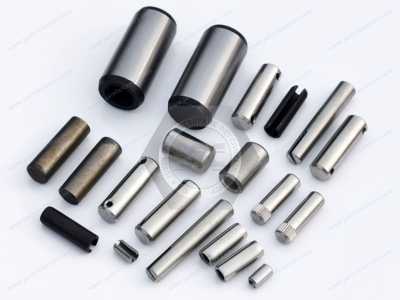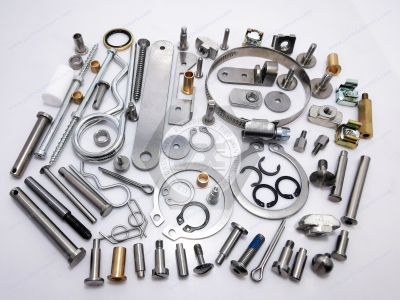Call Us
+86 136 6007 9809
Call Us
+86 136 6007 9809
Nov. 04, 2023
What is the difference between an elastic pin and a cylindrical pin?
A spring-loaded pin (a tension pin or roll pin) is a mechanical fastener used to hold two or more machine parts in relative position. The body of a spring-loaded pin is larger than the diameter of the hole and is chamfered at one or both ends to facilitate the insertion of the pin into the hole. The spring action of the pin permits it to compress when the diameter of the hole is assumed. The force exerted by the pin against the hole wall retains it in the hole, and thus, the spring-loaded pin is considered a self-retaining fastener. Elastic sales can be used to secure shafts as journals in plain bearings, as a type of key for securing one shaft to another, or to accurately secure the planes of mating parts together through symmetrical hole locations.
Cylindrical pins are generally used for coupling, locking of parts, or positioning of assemblies and can also be used as parts of safety devices. Cylindrical pins are fixed in the hole by interference, used to improve the parts, transfer power, or as a locating piece. Cylindrical pins are locating pins used to improve the relative position between parts. It is an essential auxiliary part in combination processing and assembly. Simple structure, good alignment, high load carrying capacity, good performance of variable load and impact, but requires high machining accuracy of the mating surface. The dismantling force is large, which will bruise the matching surface and belong to the non-disassembly connection. There is little interference or hydraulic mounting and dismounting; the coupling is also removable.
1. There are two types of spring pins: slotted spring pins and helical spring pins.
Helical springs or spiral pins are self-retaining engineered fasteners manufactured by rolling a metal strip into a spiral cross-section of 2+1⁄4 coils. The body of the rolled spring pin is larger than the recommended hole diameter and is chamfered at both ends to facilitate the pin insertion into the hole. The spring action of the pin allows it to compress when the hole diameter is assumed.
Compression begins at the outer edge when a coil spring pin is installed and moves through the coil toward the center. When a load is applied to the pin, the coiled pin continues to flex after insertion, providing excellent performance to resist fatigue in dynamic applications. Coiled cylindrical pins are available in three different applications: Standard (ISO 8750), Heavy Duty (ISO 8748), and Light Duty (ISO 8751), and they offer a variety of combinations of strength, flexibility, and diameters to accommodate different mating body materials and performance requirements. Typical materials for coil spring pins include high carbon steel, stainless steel, and alloy 6150.
Coiled pins are used as hinge pins in vanity cases, automotive door handles, locks, and latches. They are also used as pivots and shafts for aligning and stopping, holding multiple components together, such as gears and shafts, and even as thimbles to remove motherboards from PCs. The automotive and electrical industries use rolled pins in products such as steering boxes and columns, pumps, motors, and circuit breakers.
2. Ordinary Cylindrical Pins are widely used in various industries such as machine tools, automobiles, ships, electrical equipment, etc. They are mainly used for connecting and fixing mechanical parts and components and are characterized by compact structure and easy installation. Ordinary cylindrical pin production uses forging, drawing, or sheet metal molding processes, and then, after turning, grinding, and surface treatment processes, it is made of the final cylindrical pin products. Compared with other parts, the process requirements of ordinary cylindrical pins are relatively low, with a short production cycle, low cost, and other advantages.
As commonly used parts in mechanical transmission, elastic and cylindrical pins have essential roles. So, what is the difference between these two parts? Now, from the comparison's use, structure, characteristics, and other aspects, a detailed description of their similarities and differences.
Uses
Elastic Pin: An elastic pin, also known as a tension pin, is mainly used for connecting shaft and hole parts. It is characterized by free expansion and contraction, good elasticity, and the ability to cushion vibration and shock within a specific range.
Cylindrical pins: Cylindrical pins are usually used to locate parts, such as fixing machine parts and clamps for assembly jigs. Its primary role is to withstand the shear and rotational forces to ensure the assembly's accuracy.
Structure
Elastic pins: Elastic pins are usually elongated springs with hooks inserted into the shaft and holes at each end. There are also elastic pins with a circular shape, which are often used for connecting parts. The structure of the adjustable pin is simple, and the material is usually spring steel, which has good elasticity.
Cylindrical pins: Cylindrical pins are constructed by a cylinder plus two retaining rings in the center. Cylindrical pin size generally refers to the diameter and length of different diameters of the cylindrical pin to withstand various loads.


Features
Elastic Pin: The most crucial feature of the adjustable pin is better cushioning and anti-vibration effects. Its compact design enables a tighter connection between the shaft and the hole. Another advantage of the flexible pin is its simplicity and ease of use. No additional assembly tools are required; insert them into the hole or shaft.
Cylindrical pins: Cylindrical pins are characterized by their ability to withstand shear and rotational forces, thus ensuring accuracy throughout the machine. They are available in different diameters and lengths to meet additional usage requirements. In addition, cylindrical pins are usually made of high-quality alloy steel, characterized by high strength and wear resistance.
By comparing and analyzing the above, we can conclude the respective characteristics of elastic and cylindrical pins. Adjustable pins are suitable for shaft and hole connections that require vibration protection and cushioning. In contrast, cylindrical pins are ideal for connections that are used to locate and withstand rotational forces. The two parts have different characteristics, advantages, and disadvantages, and therefore, also need to be selected according to the specific use needs.
There is a difference between elastic pins and cylindrical pins. Adjustable pins are suitable for connecting shafts and holes, with better cushioning and anti-vibration effects. In contrast, cylindrical pins are ideal for positioning and bearing rotational force connections and have high strength, wear resistance, and other characteristics. The two kinds of parts are suitable for different areas and must be selected according to the specific use needs.
If you are looking for high-quality automotive fastener screws & all kinds of plastic fasteners or technical support for structural design, please get in touch with me. Use our new Product Finder tool, download our Product Catalog, and let us help you get custom parts.adelajonly@gmail.com. Thanks. Website: www.juxinfasteners.com
Contact Us
Tel.:
+86 020 8621 0320
+86 020 3121 6067
Technical Support:
Navigation
SEND INQUIREY